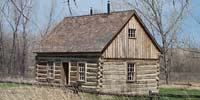Lewis & Clark: TR National Park

 2:44
Barrett Golding
2:44
Barrett Golding
Theodore Roosevelt goes country & western.
Broadcast: Feb 16 2004 on NPR Day to DaySeries: Lewis & Clark Trail: 200 Years Later Subjects: Historical, Environment
Profile: Audio postcard from Theodore Roosevelt National Park in North Dakota
February 16, 2004 from Day to Day
ALEX CHADWICK, host: This is DAY TO DAY. I'm Alex Chadwick.
If you didn't go to work today, you have 43 presidents to thank. We at DAY TO DAY are working, but in the spirit of the season and because there are as yet no Presidents Day greeting cards, we a small radio postcard with a semipresidential theme.
As a young man, Theodore Roosevelt spent time in the Badlands of North Dakota. And here is chief naturalist Bruce Kaye from the Theodore Roosevelt National Park in North Dakota.
(Soundbite of a train whistle blowing)
Mr. BRUCE KAYE (Chief Naturalist, Theodore Roosevelt National Park): It's a sound Theodore Roosevelt would have known quite well when he stepped off the train on September 9th, 1883.
(Soundbite of train whistle blowing)
Mr. KAYE: And you're standing right next the Maltese Cross Cabin, which was Theodore Roosevelt's first home here in the Badlands. He came out here to hunt bison. When he was a young boy, he had read about stories and people talked about that there were millions of bison, some say 50 or 60 million bison on the northern Plains. And the fact that it took him 13 days to finally find an animal too shoot--and that was his first lesson that he really learned out here, that he took to the White House, that wildlife is disappearing--elk, the wolf, the Plains grizzly--all these animals that were out here. By the time he was president, many of them no longer lived here in North Dakota.
As a president, he set land aside to protect wildlife, to protect lands. He talks about people understand that it's wantonly destructive to destroy an ancient church or a famous painting, but he said it's also equally destructive to destroy a cliff or a tree or a bird. And those are things that he wrote back then, you know, at the turn of the century, of the 20th century. He told people that if it wasn't for his time here in North Dakota, he would not have been president. This was where he learned the ideas of fair play and hard work and the strenuous life, where he would be in the saddle for 24 hours or more chasing after cattle.
In this cabin, he wrote a speech in 1886 where he said, `We as a nation have to come to grips with conservation. We have to protect things for our children's children.' These are his very words. `It's not what we have that will make us a great nation, it is the way in which we use it,' which sort of sums up all of his ideas.
(Soundbite of train whistle blowing)
CHADWICK: The chief naturalist at Theodore Roosevelt National Park, Bruce Kaye. That piece was produced by Barrett Golding of the Hearing Voices Radio Project.

